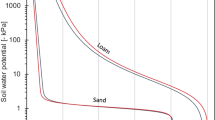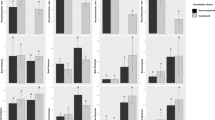Abstract
The relative importance of roots and AM-fungi on soil physical processes was investigated by controlling the presence of roots and AM fungi in pot experiments using a mycorrhiza-defective tomato mutant and a wild-type tomato (Solanum lycopersicum L.). Root-Zone and Bulk Soil sections were established by splitting pots into two lengthwise halves using a nylon mesh that contained roots whilst allowing the free movement of fungal hyphae. Post-incubation microbial populations and fungal biomass were measured and related to soil stability, pore structure and water repellency. Unplanted controls consistently had the least fungal biomass, fatty acids, water-stable aggregates (WSA) and water repellency. Wild-type-planted treatments had significantly more WSA than mycorrhiza-defective treatments (P < 0.01). Fluctuations in water content induced by transpiration caused significant changes in soil pore structure, measured using high-resolution X-Ray computer tomography. Porosity and mean pore size increased in soil aggregates from planted treatments, which had larger more heterogeneous pores than those in the unplanted soils. AM fungi accentuated soil stability. However, changes were not linked to repellency and fungal biomass. The presence of plants, regardless of AM fungi, appears to have the greatest impact on increasing soil stability.






Similar content being viewed by others
References
Andrade G, Mihara KL, Linderman RG, Bethlenfalvay GJ (1998) Soil aggregation status and rhizobacteria in the mycorrhizosphere. Plant Soil 202:89–96
Augé RM (2004) Arbuscular mycorrhizae and soil/plant water relations. Can J Soil Sci 84:373–381
Augé RM, Stodola AJW, Tims JE, Saxton AM (2001) Moisture retention properties of a mycorrhizal soil. Plant Soil 230:87–97
Augé RM, Sylvia DM, Park S, Buttery BR, Saxton AM, Moore JL et al (2004) Partitioning mycorrhizal influence on water relations of Phaseolus vulgaris into soil and plant components. Can J Bot 82:503–514
Barker SJ, Stummer B, Gao L, Dispain I, O’Conner PJ, Smith SE (1998) A mutant Lycopersicon esculentum Mill. with highly reduced VA mycorrhizal colonisation: isolation and preliminary characterisation. Plant J 15:791–797
Barley KP (1953) The root growth of irrigated perennial pastures and its effect on soil structure. Aust J Agric Res 4:283–291
Bearden BN, Petersen L (2000) Influence of arbuscular mycorrhizal fungi on soil structure and aggregate stability of a vertisol. Plant Soil 218:173–183
Beare MH, Bruce R (1993) A comparison of methods for measuring water-stable aggregates: implications for determining environmental effects on soil structure. Geoderma 56:87–104
Bond RD (1964) The influence of the microflora on the physical properties of soils: I. Effects associated with filamentous algae and fungi. Aust J Soil Res 2:111–122
Bradford MM (1976) A rapid and sensitive method for the quantification of microgram quantities of protein utilizing the principle of protein-dye binding. Anal Biochem 72:248–254
Bronick CJ, Lal R (2005) Soil Structure and management: a review. Geoderma 124:3–22
Caravaca F, Hernandez T, Garcia C, Roldan A (2002) Improvement of rhizosphere aggregate stability of afforested semiarid plant species subjected to mycorrhizal inoculation and compost addition. Geoderma 108:133–144
Cavagnaro TR, Jackson LE, Six J, Ferris H, Goyal S, Asami D et al (2006) Arbuscular mycorrhizas, microbial communities, nutrient availability, and soil aggregates in organic tomato production. Plant Soil 282:209–225
Chenu C (1989) Influence of a fungal polysaccharide, scleroglucan, on clay microstructures. Soil Biol Biochem 21:299–305
Chenu C, Guerif J (1991) Mechanical strength of clay minerals as influenced by an adsorbed polysaccharide. Soil Sci Soc Am J 55:1076–1080
Cosentino D, Chenu C, Le Bissonnais Y (2006) Aggregate stability and microbial community dynamics under drying-wetting cycles in a silt loam soil. Soil Biol Biochem 38:2053–20632
Czarnes S, Hallett PD, Bengough AG, Young IM (2000) Root- and microbial-derived mucilages affect soil structure and water transport. Eur J Soil Sci 51:435–443
Dalton FN (1995) In-situ root extent measurements by electrical capacitance methods. Plant Soil 173:157–165
Denef K, Six J, Bossuyt H, Frey SD, Elliott ET, Merckx R et al (2001) Influence of dry–wet cycles on the interrelationship between aggregate, particulate organic matter, and microbial community dynamics. Soil Biol Biochem 33:1599–1611
Feeney DS, Crawford JW, Daniel T, Hallett PD, Nunan N, Ritz K et al (2006a) Three-dimensional micro-organisation of the soil–root–microbe system. Microb Ecol 52:151–158
Feeney DS, Hallett PD, Rodger S, Bengough AG, White NA, Young IM (2006b) Impact of fungal and bacterial biocides on microbial induced water repellency in arable soil. Geoderma 135:72–80
Guggenberger G, Frey SD, Six J, Paustian K, Elliott ET (1999) Bacterial and fungal cell-wall residues in conventional and no-tillage agroecosystems. Soil Sci Soc Am J 63:1188–1198
Hallett PD, Young IM (1999) Changes to water repellence of soil aggregates caused by substrate-induced microbial activity. Eur J Soil Sci 50:35–40
Hallett PD, Ritz K, Wheatley RE (2001) Microbial derived water repellency in golf course soil. Int J Turfgrass Soc 9:518–524
Haynes RJ, Swift RS (1990) Stability of soil aggregates in relation to organic constituents and soil water content. J Soil Sci 41:73–83
Hewitt EJ (1966) Sand and water culture methods used in the study of plant nutrition, 2nd edn. Commonwealth Agricultural Bureau, London, p 547
Issa OM, Defarge C, Le Bissonnais Y, Marin B, Duval O, Bruand A et al (2007) Effects of the inoculation of cyanobacteria on the microstructure and the structural stability of a tropical soil. Plant Soil 290:209–219
Jastrow JD, Miller RM, Lussenhop J (1998) Contributions of interacting biological mechanisms to soil aggregate stabilization in restored prairie. Soil Biol Biochem 30:905–916
Kiem R, Kandeler E (1997) Stabilization of aggregates by the microbial biomass as affected by soil texture and type. Appl Soil Ecol 5:221–230
Magid J, Kjaergaard C, Gorissen A, Kuikman PJ (1999) Drying and rewetting of a loamy sand soil did not increase the turnover of native organic matter, but retarded the decomposition of added 14C-labelled plant material. Soil Biol Biochem 31:595–602
McGonigle TP, Miller MH, Evans DG, Fairchild GL, Swan JA (1990) A new method which gives an objective measure of colonization of roots by vesicular-arbuscular mycorrhizal fungi. New Phytol 115:495–501
Miller RM, Jastrow JD (1990) Hierarchy of root and mycorrhizal fungal interactions with soil aggregation. Soil Biol Biochem 22:579–594
Miller RM, Jastrow JD (2000) Mycorrhizal fungi influence soil structure. In: Kapulnik Y, Douds DD (eds) Arbuscular mycorrhizae: molecular biology and physiology. Kluwer Academic, Dordrecht, pp 1–21
Passioura JB (1988) Water transport in and to roots. Annu Rev Plant Physiol Plant Mol Biol 39:245–265
Raimbault BA, Vyn TJ (1991) Crop rotation and tillage effects on corn growth and soil structural stability. Agron J 83:979–985
Read DB, Bengough AG, Gregory PJ, Crawford JW, Robinson D, Scrimgeour CM et al (2003) Plant roots release phospholipid surfactants that modify the physical and chemical properties of soil. New Phytol 157:315–326
Rillig MC (2005) A connection between fungal hydrophobins and soil water repellency? Pedobiologia (Jena) 49:395–399
Rillig MC, Wright SF, Eviner VT (2002) The role of arbuscular mycorrhizal fungi and glomalin in soil aggregation: comparing effects of five plant species. Plant Soil 238:325–333
Roberson E, Firestone M (1992) Relationship between desiccation and exopolysaccharide production in a soil Pseudomonas sp. Appl Environ Microbiol 58:1284–1291
Roberson EB, Sarig S, Shennan C, Firestone MK (1995) Nutritional management of microbial polysaccharide production and aggregation in an agricultural soil. Soil Sci Soc Am J 59:1587–1594
Ruzicka S, Norman MDP, Harris JA (1995) Rapid ultrasonication method to determine ergosterol concentration in soil. Soil Biol Biochem 27:1215
Schutter ME, Dick RP (2000) Comparison of fatty acid methyl ester (FAME) methods for characterising microbial communities. Soil Sci Soc Am J 64:1659–1668
Selbmann L, Stingele F, Petruccioli M (2003) Exopolysaccharide production by filamentous fungi: the example of Botryosphaeria rhodina. Antonie Van Leeuwenhoek Int J Gen Mol Microbiol 84:135–145
Six J, Elliott ET, Paustian K (2000) Soil structure and soil organic matter: II. A normalized stability index and the effect of mineralogy. Soil Sci Soc Am J 64:1042–1049
Steinberg PD, Rillig MC (2003) Differential decomposition of arbuscular mycorrhizal fungal hyphae and glomalin. Soil Biol Biochem 35:191–194
Thomas RS, Franson RL, Bethlenfalvay GJ (1993) Separation of vesicular-arbuscular mycorrhizal fungus and root effects on soil aggregation. Soil Sci Soc Am J 57:77–81
Tisdall JM, Oades JM (1982) Organic matter and water-stable aggregates in soils. J Soil Sci 33:141–163
Vieheilig H, Coughlan AP, Wyss U, Piche Y (1998) Ink and vinegar, a simple staining technique for arbuscular-mycorrhizal fungi. Appl Environ Microbiol 64:5004–5007
Whalley WR, Riseley B, Leeds-Harrison PB, Bird NRA, Leech PK, Adderley WP (2005) Structural differences between bulk and rhizosphere soil. Eur J Soil Sci 56:353–360
White NA, Hallett PD, Feeney D, Palfreyman JW, Ritz K (2000) Changes to water repellence of soil caused by the growth of white-rot fungi: studies using a novel microcosm system. FEMS Microbiol Lett 184:73–77
Wright SF, Upadhyaya A (1998) A survey of soils for aggregate stability and glomalin, a glycoprotein produced by hyphae of arbuscular mycorrhizal fungi. Plant Soil 198:97–107
Wright SF, Upadhyaya A (1999) Quantification of arbuscular mycorrhizal activity by the glomalin concentration on hyphae. Mycorrhiza 8:283–285
Wright SF, Anderson RL (2000) Aggregate stability and glomalin in alternative crop rotations for the central Great Plains. Biol Fertil Soils 31:249–253
Wright SF, Franke-Snyder M, Morton JB, Upadhyaya A (1996) Time course study and partial characterization of a protein on hyphae of arbuscular mycorrhizal fungi during active colonization of roots. Plant Soil 181:193–203
Wright SF, Starr JL, Paltineanu IC (1999) Changes in aggregate stability and concentration of glomalin during tillage management transition. Soil Sci Soc Am J 63:1825–1828
Acknowledgements
This work was partly funded by The University of Abertay, The Scottish Crop Research Institute (SCRI) and the Biotechnology and Biological Sciences Research Council (BBSRC Ref. D20454). SCRI receives grant-in-aid support from the Scottish Government Rural and Environment Research and Analysis Directorate. The authors wish to thank Susan Barker and Sally Smith for supplying the mutant and non-mutant seeds and for their comments on the original manuscript. The BBSRC funded D. Feeney’s visit to the University of Montana.
Author information
Authors and Affiliations
Corresponding author
Additional information
Responsible Editor: Hans Lambers.
Rights and permissions
About this article
Cite this article
Hallett, P.D., Feeney, D.S., Bengough, A.G. et al. Disentangling the impact of AM fungi versus roots on soil structure and water transport. Plant Soil 314, 183–196 (2009). https://doi.org/10.1007/s11104-008-9717-y
Received:
Accepted:
Published:
Issue Date:
DOI: https://doi.org/10.1007/s11104-008-9717-y




